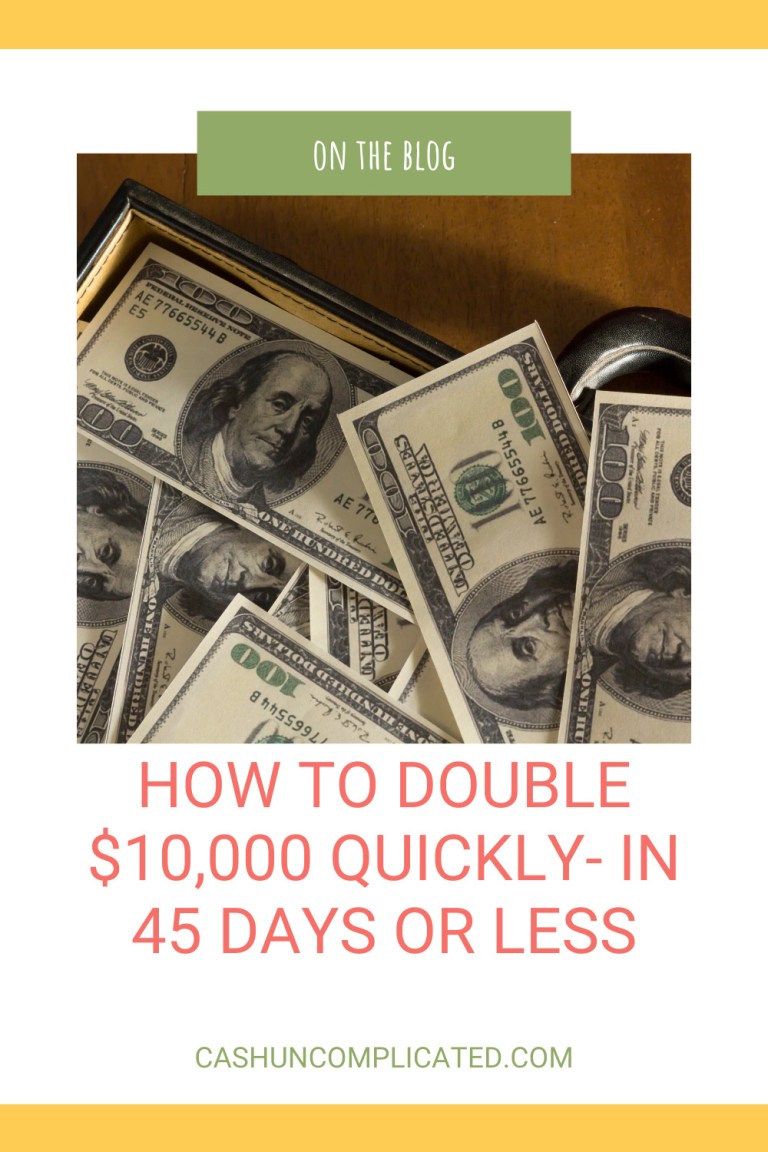I’m big on goal-setting. An entire chapter of my book Cash Uncomplicated is dedicated to goal setting. In the book, I include short-term financial goals as well as medium and long-term. All important, and all very different.
I’ve also written a detailed post about setting long-term goals, which incorporates short-term and medium-range goals.
Related post: Crushing Your Long-Term Financial Goals
This post will focus specifically on short-term financial goals—including the what, why, parameters, plus a bonus of 29 examples to help get you started.
What are Short-Term Financial Goals?
For the purposes of this post, we’ll define short-term financial goals as anything that can be accomplished in six months or less. Some can be accomplished in less than an hour, others may take more planning and execution.
Additionally, some short-term goals will be relatively easy to accomplish while others will be more challenging and require more thought. Short-term goals are a way to begin making progress and begin changing things for the better.
Accomplishing them won’t change your life immediately but the compound effect of setting and completing multiple short-term goals over longer periods of time is significant.
Why Have Short-Term Financial Goals?
Big life goals can be overwhelming. Setting a long-term goal to become a multi-millionaire by the year 2035 is a great goal. The year is specific and there’s a set time deadline. However, a long-term goal like this is going from A to Z.
Short-term financial goals allow you to make stops on the way to Z. You can go from A to B, B to C, and C to D. The accumulation of these goals is what takes us to Z. As long as we’re staying the course and following the plan, it’s almost inevitable that we reach Z, or the end goal.
Setting short-term financial goals also allows us to reach simple milestones, even without a longer-term goal specifically in mind. Maybe there’s a pesky little consumer debt you want to quickly eliminate, or want to set up a side hustle to make a little extra money this month.
Short-Term Financial Goal Expectations
While short-term financial goals can vary in difficulty and time commitment, they all share a set of similar expectations. They should all be:
- Specific:
- Measurable:
- Have a definite ending point
Example: Retire on December 31st, 2034 with a 1.85 million-dollar net worth. This goal meets all three criteria.
- A 1.85 million-dollar goal is specific
- 85 million-dollars is measurable
- December 31st, 2034 is a definite ending point
These three elements are very similar to three of the principles in SMART goals, which stands for:
- Specific
- Measurable
- Achievable
- Realistic
- Time parameters as in set in a specific time frame
The example goal above also meets all five criteria of these criteria. For more on SMART goals, see this post on TonyRobbins.com.
Short-Term Financial Goals: 29 Ideas to Start
This will be the longest section of the post. Tangible examples anyone can implement today, regardless of current financial situation. These can be executed in order, or taken out of order—both methods work. The idea is to get you started with small wins that will help build a solid financial foundation for years to come.
Number 1: Write Down Five of Your Most Important Values
This seems easy enough, but it can be challenging if we’re not already clear on what want. Write down five of your most important values. Some questions to help get you started:
- What’s most important to you?
- If you had to eliminate everything but five things, what would they be?
- What do you want to be remembered for?
- How do you want your children to view you?
The reason for this exercise is to clearly identify what you value. Many people find after completing their value assessment that they are spending money on things they don’t value. Once this realization occurs, it’s easier to spend on the things you do value and eliminate or cut back on what you don’t.
For more detailed information on how to complete your value assessment, read chapter one of my book Cash Uncomplicated and use the template found here.
Number 2: Increase Net Worth by 1 Percent
Goals like double my income, become a millionaire, and retire early can be overwhelming. A short-term goal like increasing your net worth by one percent isn’t so overwhelming though. It’s just one percent, something anyone can find a way to do.
A few examples for a net worth of:
- $1,000: Increase by $10
- $10,000: Increase by $100
- $100,000: Increase by $1,000
- $1,000,000: Increase by $10,000
One percent isn’t easy but it is achievable. It’s about taking the small steps to help you reach bigger milestones. Growth doesn’t happen overnight—small growth is one way to start.
Number 3: Create an Emergency Fund
Not all emergency funds look the same. Many financial experts recommend three to six months, while others recommend nine months to a year. If you have a secure job, maybe a couple months is all you need.
The amount in the emergency fund varies from person to person and depends on individual needs and the intangible of the amount needed to help you sleep better at night. Speak with your financial advisor and CPA to hone in on a more specific timeframe. No matter what your timeframe is, we all have the ability to create an emergency fund.
Whether you want one month of an emergency fund, five months, or a full year—the important thing is to start. The short-term goal here is simply to create an emergency fund. Once you get it started, you can figure out the rest like how much to contribute monthly or what your end goal is.
Related:
How Much of an Emergency Fund Should You Really Have?
The Broken Down Car and the Emergency Fund
Why the Pandemic Prompted Me to Increase My Emergency Fund
Number 4: Save 100 Dollars More This Month
It’s daunting to try and go from saving nothing every month to saving thousands of dollars. Make it easy for yourself and start with an achievable short-term goal. Simply save $100 more this month than you did last month.
If you saved nothing last month, save $100 this month. If you saved $500 last month, make it $600. Or even if you saved $5,000 last month, make it $5,100. Creating a round number like $100 puts that goal in the forefront of your mind, which allows your brain to go to work for you and save that amount.
There’s no pressure to repeat the process, the only goal here is to save $100 more this particular month. After you complete the challenge, you may decide you want to repeat it the next month. But don’t worry about that right now, just worry about saving $100 extra this month.
A few ways to accomplish this:
- If a dinner out costs an average of $50, cook dinner at home two more times this month to equal $100
- If going out to lunch costs $10, make lunch at home 10 days
- Work a side hustle for a few hours
- Sell used items online
- Combine methods
Number 5: Set up an Automation
Automating my money was one of the best things I did to move my personal finances forward. It took away the monthly struggle I used to have with investing an appropriate amount of money. Now I pay myself first by automatically having a portion of my income taken out at the start of the month.
I don’t have to think about it or take any additional action. All the work has been done, other than the periodic adjustments I make as my income increases. Fortunately, this very important step can be broken down into a short-term goal.
The short-term goal is simply to set up an automation. Even if you need to start by automating only a few dollars a month, the key is to start and begin building up the habit. You can always add money later, just like I have and continue to do.
Related:
Keep it Simple—4 Financial Habits You Can Start Today
Number 6: Open an Investment Account
Even if you don’t have much money to contribute right now, open an investment account. The simple act of opening the account will get you thinking about how to contribute to it. And everyone has to start somewhere. It’s the start to a new financial habit.
I’ve known many people who began investing by contributing less than $100 per month to start. That number eventually exceeded thousands of dollars per month, and they are now on the fast track to financial independence, or already there. The act of opening the account is the first step to forming hopefully what becomes a lifetime habit of investing.
Number 7: Create a Written Plan
It’s one thing to think about goals, or desire to do something. It’s another thing to sit down and actually write down those goals. That’s why creating a written plan is so powerful.
Take some time to write down a financial plan. It can be something as basic as a few goals accompanied by some ideas about how you’re going to accomplish them. Take some time and continue to add to your list.
Remember, the short-term goal here is to simply create the plan. What you do with it after is up to you. For best results, share the plan with your spouse or partner, and work with a financial advisor or CPA to solidify the details.
Number 8: Set Three Long-Term Financial Goals
Create three long-term financial goals. Be specific and set a date in which the goal is to be completed. For more on setting long-term goals, read this post I wrote a few months ago.
For now, don’t worry about all the details. Just set three long-term goals and you can iron out all the details later. The idea here is to get the goals on paper so you can begin working toward them. They’re not going to be perfect and you’ll have plenty of opportunity later to adjust and revise them.
Number 9: Make an Appointment with a CPA or Financial Advisor
The short-term goal here is to just make an appointment with a CPA and/or Financial Advisor. Do a little research, ask a few friends, and find someone who is a good fit. This is one of the first dominos to knock over to create a solid and consistent financial plan.
Number 10: Review Housing Situation
What’s your current housing situation? Have you been renting for years and want to buy a house? Do you have a vacant bedroom you want to rent out on Airbnb or the traditional route? Are you paying too much in rent and want to find a less expensive place?
Conducting a review of your housing situation will help you answer all these questions and more. One of the best ways to gain clarity in any situation is by asking the right questions. Formulate a few important questions in regards to your housing situation and honestly answer them.
After completing this brief exercise, you may find that:
- Your current housing situation is just right
- The location and amenities you used to value when you first moved in are no longer valuable to you and moving to a less expensive area makes sense
- You want to try your hand at renting a room out to cut down on your mortgage/rent
- There’s opportunity to rent your house out a few weekends a year on a vacation rental platform like Airbnb or Vrbo.
Number 11: Review Your Spending
Go over your bills for the last few months and ask yourself questions like these:
- Does your spending align with your values?
- Is there anything you’ve been spending on that you don’t use anymore?
- Subscription services, gym memberships, etc.
- Are you paying yourself first?
The answers to these questions will provide clarity on what you’re doing right, and what can be improved upon. If you’re spending $50 a month on a gym membership you never use anymore, eliminate it. Or if you regularly use the gym membership but have a couple online subscriptions you never use—keep the gym membership and eliminate the online subscriptions.
Number 12: Audit Your Subscriptions
Piggybacking off the last tip, audit all your subscriptions. Over time our interests change. Which means subscription services we used to find valuable may not be valuable to us anymore. And when things aren’t valuable or used, they should be eliminated.
For example, I used to go to the gym regularly. I’ve since changed my workouts to outdoor workouts using a program my wife likes. I prefer the new workouts so I cancelled my gym membership. I may eventually go back to the gym, but for now I’ll be using the new workouts and save the money.
Number 13: Review Insurance Policies
Pull up all of your insurance policies and review them. Make sure you are adequately covered and are being offered appropriate rates. Call around and talk to a few different insurance companies to get their expertise.
You may find you are adequately covered-or you might discover that you are over- or under-insured. The idea is to have the right coverage at a price that works for you. Since I am not an insurance expert, it’s important to reach out to the experts and make your decisions based off reliable information.
Number 14: Talk With an Attorney About Creating a Trust
I’m not a lawyer, but I have been by told by many of them to create a trust. So I created one—and recommend you reach out to an attorney to do the same. Creating a trust has helped me sleep better at night knowing that my assets will be handed down to the people I want to have them.
There are also many other components to the trust I wasn’t even aware of, such as how I want family members to make medical decisions on my behalf if I am unable to. Write down questions you have and make an appointment to speak with an attorney.
Number 15: Read Two Personal Finance Books
There are literally hundreds, if not thousands, of personal finance books available. The reality is that nobody has the time or energy to read every book ever written. To make things simple, make it a goal to read just two books in the next month or two.
Even two books will give you a good introduction to personal finance and enough basic knowledge to start making potentially life-changing decisions. This is a list of my five favorite personal finance books—pick two off the list and read them, or find two of your own. I even included my book at the end as a bonus!
- The Millionaire Next Door
- The Richest Man in Babylon
- The Simple Path to Wealth
- Rich Dad Poor Dad
- The Automatic Millionaire
- Cash Uncomplicated
Number 16: Take a Course or Attend a Seminar
Books are great and a fantastic start for anyone to begin their personal finance journey. Courses and seminars are a different way to obtain and apply information. Online courses usually offer a structured format with the ability to reach out to the course creator for support and questions.
Seminars often involve dozens, hundreds, or even thousands of other people. There’s a certain energy you get from like-minded people in the room that’s hard to replicate in other ways. Seminars are also a great way to meet other people with similar goals, who can help push you to new levels. Some may even become friends.
Number 17: Learn About One Type of Investment
People often get overwhelmed with the sheer amount of investment opportunities available. Analysis paralysis can occur as a result, and nothing gets done. Or we can all be guilty of the “shiny object syndrome”, where we move from investment to investment and never get good at any of them.
To simplify, spend some time learning one type of investment. It doesn’t matter what it is—just pick something and learn about it. You don’t even have to take action yet, the goal here is to just learn about it.
Number 18: Get Rid of Junk and Sell It
In this section, we’ll kill two birds with one stone. If you have junk in your house—get rid of it and sell it. Not only will you rid yourself of clutter, but you’ll also make a little money at the same time.
If you have just a few things you want to get rid of, set a short-term goal of getting rid of all of it at once. And if you have a lot of clutter and junk, set a goal to get rid of one room, or one section of the house at a time. Setting smaller goals like one room at a time helps prevent getting overwhelmed and not taking any action at all.
Related:
I Need Money Now! How Anyone Can Make 500 Dollars Fast
Number 19: Create a Debt Payoff Plan
Bad debt can be suffocating. Credit cards here, car loans there, and more credit cards. The whole situation can feel hopeless. One of the best ways to combat what feels like a lost cause it to take action.
And creating a debt payoff plan is a great way to take action. You don’t have to pay off all the debts at one time, you just need to start by making a plan. The simple act of making a plan will help reduce some of the anxiety and feelings of being overwhelmed.
Plan the order you want to pay off your debts and create some timeframes for when the debt will be paid off. Determine how much you can pay per month and then get to work. There are a few different strategies to pay off debt, see this post for more details.
Related:
The Psychology of Paying Off Bad Debt
Number 20: Pay Off One Consumer Debt
Apropos to the last section, after you’ve created your debt payoff plan, begin to pay off one debt. Focus on that one debt, that’s all that matters at this time. Even if you have a lot more consumer debt, continue to focus on one debt at a time.
If you’re someone with a lot of consumer debt, there’s not a magic formula to paying it all off at one time, other than bankruptcy maybe—which is way outside the scope of this website. It helps me to focus on what I can control, which in the case of consumer debt payoff, is paying off one debt at a time.
Start by paying off one debt and try not to worry about the rest. You can control your progress towards paying off one debt—focus on that action.
Related:
Debt Snowball, Debt Avalanche, or Hybrid Method—Which Should You Choose?
Number 21: Reduce or Eliminate One Expense
Is there one expense you can either reduce or eliminate completely? Let’s use an example of someone who orders takeout five times a week at an average of $30 per meal. The total cost of takeout per week is $150. For the month, that’s usually around $600.
A great short-term goal is to reduce the amount of takeout ordered and replacing it with cooking. Even reducing five days a week of takeout to three days a week saves $60 per week minus the cost of cooking at home (almost always considerably less expensive). For the month, that equals about $240.
A goal of simply reducing the amount of takeout per week comes with a monthly savings of over $200. Very little effort expended and this person doesn’t have to stop ordering takeout cold turkey. Plus there’s room to further reduce this expense if they choose to down the road.
Common expenses that can be reduced or eliminated:
- Going out to eat
- Plane flights (via travel hacking)
- Ordering coffee out
- Entertainment costs
Number 22: Optimize Loans
If you have any type of loan, shop around for better rates. Make it a short-term goal to contact two or three lenders for each loan to optimize rates. With interest rates still at historic lows, there is a lot of opportunity to get incredibly low interest rates.
This is an especially great short-term goal for larger debts like your house payment or a loan for a rental property. Make it a point to work with reputable lenders and ask them any questions you might have. You can even use the same questions for different people and compare and contrast how they answer each one.
Number 23: Track Your Spending for One Week
Tracking your spending doesn’t mean you have to commit to a full year of writing down everything you purchase. You may ultimately end up tracking your spending for a year or more, but you don’t have to commit to that right out of the gate.
Try tracking your spending for just one week. The insight you’ll gain about your spending habits is significant. When I first started tracking my spending I realized I was spending things I don’t value as well as things I didn’t even know I was spending on. That allowed me to make easy adjustments to what I spent on.
Use the spending tracker on the homepage of my website, write it down on your own, or use an app like Mint to track your spending. It’s an easy and achievable goal that will provide anyone with great insight in a short amount of time. Many people choose to go longer than a week and make it a regular habit to track.
Number 24: Increase Your Income
Saving and cutting spending on unnecessary and unvalued items is a great way to start on the pathway to early financial freedom. A less talked about way is by increasing your income. Make a goal to increase your income in some way.
That can be done by earning a raise at work, making more in commissions, or raising the rent on a rental property—just to name a few of many. In the next section, I’ll address the side hustle, a great way anyone can increase their income in a very short amount of time.
Number 25: Start a Side Hustle
Starting a side hustle doesn’t have to involve a large time or financial commitment. A few hours a week of driving for Uber or delivering groceries for Instacart qualifies. The side hustle doesn’t even have to be in your field of expertise, it might just be something you enjoy doing from time to time.
Beginning a side hustle definitely isn’t for everyone. Someone making six figures and working 60 plus hours per week is much better served taking some time to rest than engaging in a side hustle.
But for someone who wants to make a little extra money and is looking to fill some time, a side hustle is a great way to accomplish just that. Some even take on a series of side hustles as their primary source of income.
Related:
Gig Work: 28 of the Best Jobs & Opportunities for 2021 and Beyond
Number 26: Find a Passive Income Source
The idea of passive income has become something of a buzz phrase over the past few years—and for good reason. Although very few investments are truly 100 percent passive, they are significantly less work than traditional employment.
A great short-term goal is to go out and find a passive income source. That can be something like real estate, being a silent partner in a business, or even investing in index funds. Find something that works for your situation and take action.
Number 27: Make Dinner One More Night a Week
As we approach the end of the list, we’ll add an easy one. Make dinner one more night a week. If you’re someone who already makes dinner six or seven nights a week, you can skip this section. For the rest of us, keep reading.
Someone who makes dinner three times a week would increase that to four times a week. A person who cooks twice a week would increase that number to three. And the person who doesn’t cook at all would make one meal a week.
That’s it, that’s the goal. Just increase it by one day. Allow the habit to form as this is the first domino to fall. More improvements will follow and the results will start to compound.
Recommended Books:
Number 28: Make Coffee at Home
You can start slowly like the last short-term goal and make your coffee one more day a week at home. Or you can go all in and make your own coffee six or seven days a week. Pick the method that best suits your personality and needs.
Making your own coffee has long been a topic of debate in the personal finance community. I’m sure we’ve all seen the articles about how making your own coffee can add up to hundreds of thousands of dollars over the years. Others say it’s a waste of time and the savings are insignificant.
Curious, I explored the topic further and wrote my own post about it. Follow the link below if you are interested in how much making your own coffee actually saves you.
Related:
Brewing Your Own Coffee: Will it Really Make You a Millionaire?
Number 29: Bring Lunch to Work Four Out of Five Days
No need to be perfect here. Try a short-term goal of bringing your lunch to work four out of five days. Enjoy a lunch out the other day, whether that’s the end of the week or sometime else during the week.
I recently researched and wrote a post about how much bringing your lunch to work can save you—the savings are substantial. Even bringing your lunch to work one more day a week can result in big savings. To find out just how much you can save, follow this link.
Conclusion
Everyone likes to see the big results—going from the broke to millionaire, or zero in savings to thousands of dollars per month in cash flow. It just doesn’t work that way though. Very few people go from nothing to financial abundance.
The way to get there is by setting and achieving short-term financial goals. A series of small manageable goals that add up over time. Over the years, the fruits of your efforts begin to compound and the big goals are achieved.
Setting short-term goals is a way of organizing your life so that all you need to do is fulfill a series of small steps. Then more small steps, and more after that. Eventually those small steps turn into miles and the fulfillment of long-term goals and dreams.
So pick a few of these short-term goals and get to work. Or create a few of your own. Then repeat the process and watch the results compound.
Do you set short-term goals? How have they improved your life?














